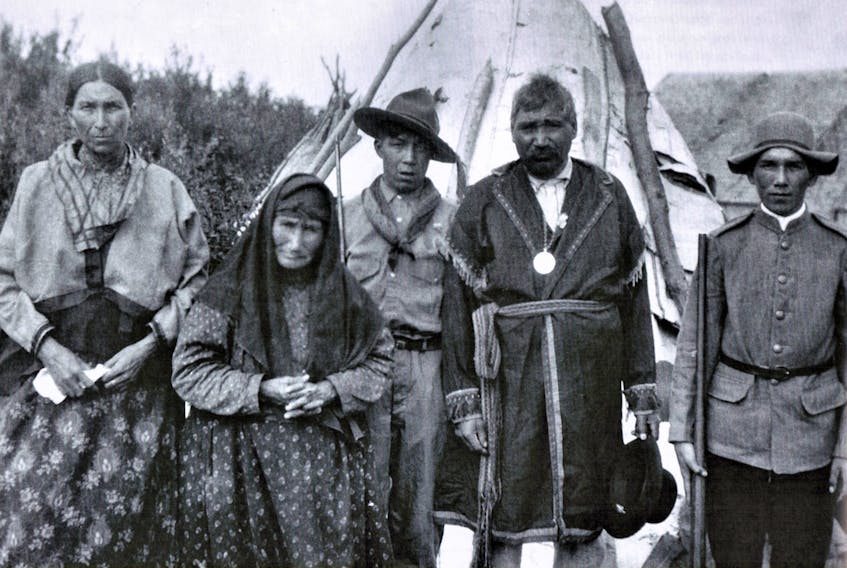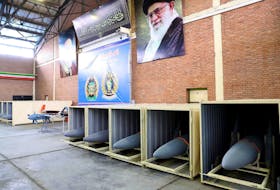The Pictou Landing First Nation has played a significant historical, cultural and social role in the very fabric and development of Pictou County. Centuries before European explorers and settlers came to the area, the Mi’kmaq had developed a form of a democratic system where the community would gather together and elect a chief. The Mi’kmaw Nation was self-governing and important decisions were contemplated through the body of the traditional Mi’kmaw government – the Mi’kmaq Grand Council. This structure found its basis at the village level, whereby a local chief presided over the council of elders of his village or band and was responsible to carry out the decisions of his group of Elders.
Although local chiefs did not hold an official position within the Sante’ Mawio’mi, their concerns were brought forth by the district chiefs. The district chief presided over his area’s council of local chiefs with the responsibility for settling issues that might cause serious conflict among the districts or between nations in regard to such matters as treaties, alliances, or in time of war.
The Sante’ Mawio’mi consisted of a seat for each of the seven districts and for the Nikanus, Kji-Keptin, Putu’s, and for the Grand Council leader, Kji-Saqmaw (Grand Chief). All discussions within the Council were based on consensus and included mutual respect and trust as a code of governance. Historians believe the Mi’kmaq “Ancient Ones” presence in the Pictou County area is thought to have begun about 3,500 to 7,000 years ago.
Some Mi’kmaq place names of Pictou County and their meanings:
Gatjipogoeg – River John: A lonely river or flowing through wilderness
Tiamoisgontjitig – Cape John: Moses’ nose
Bucto taagun – Toney River early place name: Spark of fire
Pogomgeg – Toney River: Named after Capt. Toney a Frenchman, who had adopted Mi’kmaq lifestyle
Mentemogoagentjitjg – Cariboo River: Little oyster fishing
A’se’k – Boat Harbour: Yellow Rock
Gomagain – Caribou Harbour: Decoy duck
Tetotgesit – Little Cariboo Island: Running into the bushes
Aptjitjgemotjoegatig – Trenton: Duck land
Sogolegatig – Indian Cross Point: Rotting place
Pictook or Pigtogooag – Pictou: Explosive place
Pgotamotagenigatig – Fishers Grant (Pictou Landing): Old crossing
Pigtog Oaling – Fishers Grant Reserve (Pictou Landing First Nation)
Munbegweck – Little Harbour – Little Harbour
Espakumegak – Green Hill: High land
Mallegomichk – Merigomish: Hardwood grove or place of merry making
Panogopsgalatjoegatig – Kink’s Head: Opening by a rocky hill
Iligtigiatimg - Pictou Harbour Point: Drunkards’ resort
Gonteoegatig – Quarry Island: Stone place
Sonatitjg – Big Island: Little shipyard
Gagpesagagang – French River: Good for small fishing
Wakumutkook – West River: Clear water
Pamdunook – Mount Thom: A mountain chain
Matoeseg – Pig Island (Merigomish): Porcupine place
Nemtjipogoeg – Middle River: Straight flowing
Oaletg gisna Oalitjg – Abercrombie Pt. (Fraser Pt.): Little snowballs
Amasipogoetjg – East River: Long River
Nemtogooeg – Shore between Caroboo and Pictou Harbour entrance: Running straight up
1800 – Nova Scotia Government forms a committee to study the plight of the Mi’kmaq
Census taken of Pictou Mi’kmaq, ( ) Number in family
Old Paul (2); Luland Miscatuway (10); John Tonny (4); Mattew Sapier (6); Old Sapier (4), Newell Sapier (5); John Patliz (7); Newell Patliz (5); Apem Paul (4); Francis Paul (6); Sapier Paul (8); Charles Tonny (9); Mulis Petition (2); Joseph Purnall (7).
Total in families 79.
1801 – Disease-infected Scottish immigrants land at Pictou; the Mi’kmaq of Pictou moved to the head of Guysborough River. So eager were the Mi’kmaq to avoid the disease, they chose to avoid contagion even if it meant turning down access to much-needed relief, such as food and blankets. This was the case in 1801 when Mi’kmaq from Pictou refused to go to Halifax to collect relief the Nova Scotia government allotted to 10 Indian reserves.
1808 – Letters to Nova Scotia government from Pictou’s Hugh Denoon, reporting discussions with Mi’kmaq Indians (Cape George, Pictou, Tatamagouth areas). “Having occasion to talk with several of them with respect to their opinions of war, they will join, in their words, the strongest side; once affirmed he would scalp all Pictou in two nights”.
1812 – Catholic Diocese of Antigonish requests 50 cents each year from each Mi’kmaq communicant in Pictou and Merigomish.
1820 – Nova Scotia Surveyor Charles Morris was ordered to submit a plan for tracts of land which were to be given to Mi’kmaw Indians
1821 – Charles Francis, at 12 years old, a Mi’kmaq from Pictou Landing, Nova Scotia moves to Clarke’s Head, Gander River, Newfoundland. Mi’kmaq historians maintain that the first permanent Mi’kmaq settlements in Newfoundland were in the Codroy Valley and at Bay St. George in the late eighteenth century.
1825 – A Licence to be granted Paul Chachegonous, Chief of the Tribe of Pictou, Indians for them to occupy the Land they have settled upon, on the Southeast side of East Branch of the Harbour or River Merigomish or Port, Luttrell, with Liberty of Hunting and Fishing in the Woods, Rivers and Lakes of that District.
1829 – Report to the Nova Scotia Government -"With the destruction of their (Mi’kmaq) hunting grounds came vagrant and intemperate habits, and decrease of their numbers, chiefly from drunkenness, partly from emigration. No lands for them — attributes their degeneration to maltreatment of whites."
1831 – Letter from Mr. Hugh Denoon, Pictou, reporting that he has met with the Mi'kmaq of Pictou, who have advised that they are anxious to make a permanent settlement at Boat Harbour
1835 – Letter from Father McLeod, Arsaig to Lt. Gov. Campbell regarding relief for Mi'kmaq. Includes requests from Merigomish and Pictou. “Beg leave to draw the attention of Your Excellency to the wants of the aborigines...They have with some assistance and much labour erected in Merigomisha House dedicated to the worship of Almighty God in great hopes that by the judicious application of a Small sum of money, furnished to the Indians in the shape of Tools and Clothing”.
1836 – Petition of Maltiel Sapier and other Mi'kmaq of the Pictou area to the Lt. Gov. Campbell requesting assistance, especially blankets and great coats.
1837 – Pictou Mi’kmaq petition the Nova Scotia Government pleading for food and blankets.
1842 – James Dawson wrote to the Indian Commissioner Joe Howe and reported that group of native women from Merigomish disapproved 'of any of their children being educated in the White Man's school – because? when so educated it would break off the natural ties of affection and association between them and their Tribe, and dislike and contempt would be the result.
– Letter from Dawson to Howe. He will distribute coats and blankets as per directions. Complaints that Mi'kmaq were promised liberty to cut firewood about Fisher's Grant, Boat Harbour, and now the owners have broken their promise. Firewood is scarce. A reserve is needed. Recommends land at headwaters of Barney's River, including the whole of Brown Lake and other property on the map prepared by Crerar, the Deputy Surveyor. Also, necessary to purchase 50-100 acres at Fisher's Grant, the favoured summer campsite of the Mi'kmaq. There are about 62 families: 150 individuals. Says the government must purchase or otherwise acquire land in Pictou for a Mi'kmaq reserve. "Until this be done, they will not believe that Government intends doing them any good, and they will not fall in with your measures..."
1843 – The Committee of Indian Affairs advises favourable consideration on: the petition of Rev. O'Reilly and others for a grant of money for a tract of land "for use of the Indians" in Pictou County.
1850 – Letter from William James Anderson of Pictou to G.R. Young regarding Joe Wilmot, a Mi'kmaq from Pictou who desires to send his sons to Pictou Academy. Anderson recommends that the boys be removed entirely from their families and sent to board with a white woman, Miss Wilson, a teacher at the Infant School, and only allowed to visit their families occasionally.
1855 – A report concludes “the Mi’kmaq of New Glasgow were ready to drop from hunger”.
1856 – In nearby Pictou, the Indians were “actually starving, and crying for food”. Letters from S. McQueen to J. Wilkins and Wilkins to McQueen concerning poverty and starvation among Mi'kmaq of Pictou.
1859 – Father Christian Kauder has church built at Merigomish for the Mi’kmaq people.
1862 – Noted that the Pictou Micmac made 'many unreasonable objections' to having their reserves subdivided, wishing rather to have everything in common, even their wigwam.'They wish', he said to be as children of the same family.
1865 – Request on behalf of the Mi'kmaq of Pictou for a small grant of land convenient to market in the winter and close to fishing areas.
1866 – Letter from James Lang of River John complaining that the government has not lived up to its promises to protect and preserve thousands of acres granted to the Mi'kmaq as reserves in 1859.
1867 – Upon confederation, the Federal government took control of Indian affairs in Canada under the Department of Indian Affairs. From 1867 until 1873, the Secretary of State for Canada was also named the Superintendent General of Indian Affairs.
Historical Research: Pictou Landing First Nation; Mi’kmaq Resource Centre, Cape Breton University; A List of Micmac Names, Elizabeth Frame; Micmacs and Colonists, L.F.S. Upton; Skyscrapers Hide the Heavens, J.R. Miller; Nova Scotia Archives, Mi’kmaq Holdings; Archives Canada; Pictou Antigonish Regional Library; A History of the Catholic Church in Eastern Nova Scotia, A. A. Johnston; The Old Man Told Us, Ruth Holmes Whitehead; History of the County of Pictou, Rev. George Patterson; Red Earth Tales of the Mi’kmaq, Marion Robertson.
John Ashton is a historical author, graphic and visual artist and operates a 34-year Nova Scotia registered business, Ashton Creative Design in Bridgeville, Pictou County. He may be reached at [email protected]









